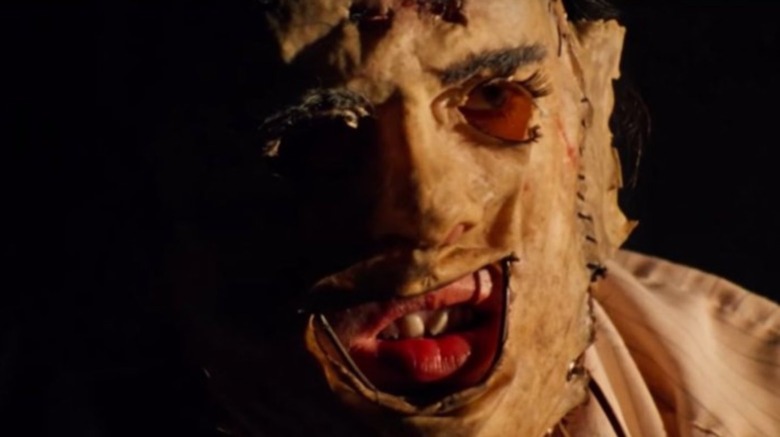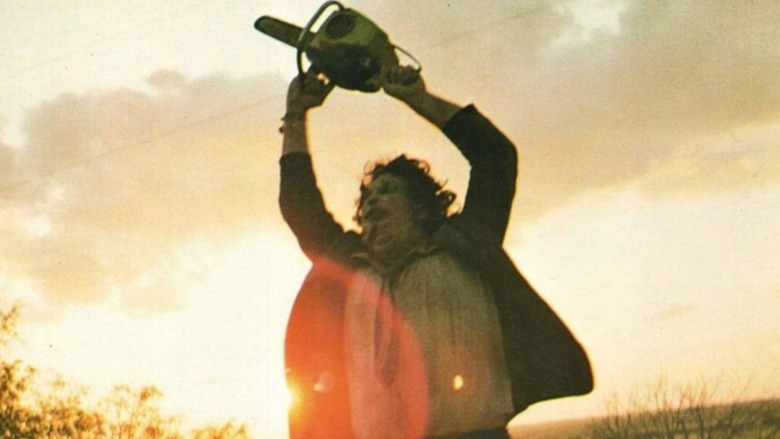Here's The Real Reason Why Leatherface Changes His Mask
If horror movie history has taught us anything, it's that every good slasher flick needs a memorable villain. Even as the likes of Freddy Krueger ("A Nightmare on Elm Street"), Jason Voorhees ("Friday the 13th"), and Michael Myers ("Halloween") feature prominently in any conversation about iconic horror villains, most genre die-hards would agree those baddies barely hold a candle to the chainsaw-wielding madman known as Leatherface. That character made his big-screen debut in director Tobe Hooper's grisly 1974 masterpiece "The Texas Chain Saw Massacre." While he's probably best remembered maniacally swinging his titular power tool in the golden light of dusk, it's a safe bet the whole of horror fandom will never forget the ghastly sight of the mask he wore in the film, a "face" which was clearly carved from the corpse of one of the Sawyer clan's many victims.
So unsettling is the sight of Leatherface throughout the film that even the most fervent fans of the film still have trouble looking at him when he's on-screen. Those who've managed to endure the mask on repeat viewings of "The Texas Chain Saw Massacre," however, would be quick to note Leatherface actually wears several different masks in the film, changing face at least twice during the horrifying, real world-inspired action.
According to the man behind the mask in the original "The Texas Chain Saw Massacre", those grotesque facial coverings were more than just horrifying props, and actually served the mangled psyche of Leatherface in a very specific way. And yes, the identity-based backstory behind why Leatherface changes masks is every bit as twisted as the film itself.
Leatherface apparently had a mask for every mood in The Texas Chain Saw Massacre
The late, great Gunnar Hansen was the actor who brought Leatherface to such horrifically vivid life in "The Texas Chain Saw Massacre." As quoted in a 2017 article from Bloody Disgusting, Hansen claims the film's writing team of Hooper and Kim Henkel told him the character's "face" changes were directly tied to his personality shifts ... meaning Leatherface had a mask for every mood. "The reason [Leatherface] wore a mask, according to Tobe and Kim, was that the mask really determined his personality," he said. "Who he wanted to be that day determined what mask he put on."
While Leatherface's nightmarish "Kill Mask" is arguably the most iconic he wears in the film, it's also the one that requires almost no backstory. However, Hansen goes on to explain the logic behind the other two, which is unnerving to the point of drastically altering how one views the scenes in which they first appear. "So when Drayton comes home with Sally, Leatherface is wearing the 'Old Lady Mask' and he's wearing an apron and carrying a wooden spoon, he wants to be domestic, helpful in the kitchen," he explained. "At dinner, he wears a different face, the 'Pretty Woman,' which has makeup."
The mere thought that Leatherface sometimes wanted to play the part of doting grandma, and on occasion just needed to feel pretty only adds to the already monumental "ick" factor behind those masks, so much so that some might prefer not to know this particular bit of background info. But in terms of narrative detail, learning of Leatherface's mood-based masking in "The Texas Chain Saw Massacre" adds a fascinating, psycho-analytical aspect to the character. And one has to admire that Hooper and Henkel put so much thought into constructing the abominable psyche of one of horror cinema's most notorious killers.

